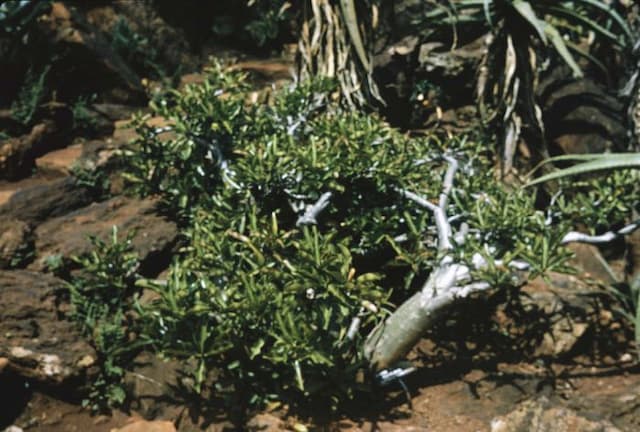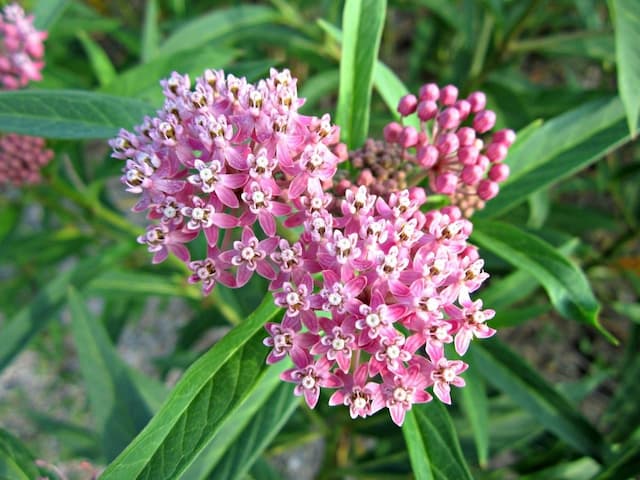Periwinkle Vinca minor 'Ralph Shugert' (v)

ABOUT
The Vinca minor 'Ralph Shugert,' commonly known as periwinkle or creeping myrtle, is an ornamental ground cover recognized for its delightful appearance. This plant exhibits glossy, dark green leaves that provide a lush backdrop to its charming flowers. The foliage often has a variegated pattern, with edges distinctively highlighted in creamy white, adding a decorative contrast to the greenery. The flowers of 'Ralph Shugert' are particularly striking. They bloom profusely in a delicate periwinkle blue—hence the common name—with a simple, yet elegant radial form. Each flower typically showcases a petite, five-petaled structure, and the blooms appear above the foliage in a manner that creates a carpet of color during its flowering season. The overall impression is one of a dense mantle of green leaves edged in white, speckled with the gentle blue of the periwinkle blossoms, presenting a beautiful display for gardens or as a natural understory in shaded areas.
About this plant
 Names
NamesFamily
Apocynaceae.
Synonyms
Lesser Periwinkle, Dwarf Periwinkle, Myrtle, Common Periwinkle.
Common names
Vinca minor 'Ralph Shugert'.
 Toxicity
ToxicityTo humans
Common periwinkle is considered mildly toxic to humans if ingested. The plant contains alkaloids such as vincamine, which can cause adverse effects. Symptoms of periwinkle poisoning may include nausea, vomiting, diarrhea, and in severe cases, low blood pressure, depression of the central nervous system, and seizures. It is important to avoid consuming any part of the plant to prevent these potential consequences.
To pets
Common periwinkle is also toxic to pets, including cats and dogs. It contains alkaloids that can cause similar symptoms as in humans, such as vomiting, diarrhea, depression, incoordination, and in severe cases, seizures, hypotension, and possibly coma if large amounts are ingested. Pets should not be allowed to ingest any part of common periwinkle to avoid these risks.
 Characteristics
CharacteristicsLife cycle
Perennials
Foliage type
Evergreen
Color of leaves
Variegated
Flower color
Blue
Height
6 inches (15 cm)
Spread
1-3 feet (30-90 cm)
Plant type
Creeper
Hardiness zones
4-9
Native area
Europe
Benefits
 General Benefits
General Benefits- Ground Cover: Vinca minor 'Ralph Shugert' serves as an excellent ground cover, preventing soil erosion and suppressing weed growth due to its dense foliage.
- Low Maintenance: This plant is easy to care for, requiring minimal upkeep once established, making it ideal for gardeners looking for low-maintenance options.
- Drought Tolerant: Once established, it can tolerate periods of drought, reducing the need for frequent watering.
- Shade Tolerant: It thrives in partial to full shade, making it suitable for planting under trees or in other shaded areas of the garden where other plants might struggle.
- Evergreen: The leaves of Vinca minor 'Ralph Shugert' remain green throughout the year, providing continuous color and coverage even in winter.
- Aesthetic Appeal: With its attractive, variegated leaves and blue-purple flowers, it adds visual interest to the landscape across seasons.
- Fast Spreading: It spreads quickly to cover bare spots in the garden, making it a quick solution for areas needing vegetation.
- Erosion Control: The thick mat of roots helps stabilize the soil on slopes, reducing the risk of erosion from rain and wind.
- Wildlife Habitat: The dense cover offers shelter for small wildlife and can be a habitat for beneficial insects.
- Adaptable: It is versatile and can be used in a variety of garden settings, from borders to rock gardens, providing consistency in garden design.
 Medical Properties
Medical Properties- Alkaloid production: Vinca minor 'Ralph Shugert' contains alkaloids, such as vincamine, which have been historically used in some cultures for their potential circulatory and cognitive benefits.
- Memory enhancement: The alkaloid vincamine may have been investigated for its potential to enhance memory and cognitive function, although its use should be approached with caution due to limited clinical evidence.
- Vasodilative effects: Vincamine is thought to exert vasodilative properties, potentially improving blood flow; however, clinical data supporting its efficacy and safety are limited.
 Air-purifying Qualities
Air-purifying QualitiesThis plant is not specifically known for air purifying qualities.
 Other Uses
Other Uses- Vinca minor 'Ralph Shugert' can be used in floral arrangements to provide a delicate green background or filler due to its attractive foliage.
- The trailing habit of the plant makes it a suitable candidate for use in hanging baskets, complementing flowering plants with its variegated leaves.
- This plant can be used as a living mulch in gardens, as it spreads to cover the ground and can help retain soil moisture.
- In large-scale landscaping projects, Vinca minor 'Ralph Shugert' serves as an erosion control solution on slopes due to its dense and extensive root system.
- The plant can be used to create a natural green carpet in shady woodland gardens, providing a lush, evergreen groundcover throughout the year.
- Its foliage can be utilized in terrariums or fairy gardens, where its miniature landscape role provides a backdrop for other miniature plants and decorative items.
- For educational purposes, Vinca minor 'Ralph Shugert' can be used to demonstrate vegetative propagation techniques to students and plant enthusiasts.
- In artistic projects, the leaves can be pressed and used in crafting, such as making bookmarks, cards, or in decoupage.
- The contrasting colors of the leaves can be inspiring in garden design, providing ideas for color coordination and texture contrasts.
- This variety, due to its ornamental appeal, can be potted and given as a gift for gardeners looking to add a low-maintenance plant to their collection.
Interesting Facts
 Feng Shui
Feng ShuiThe common periwinkle is not used in Feng Shui practice.
 Zodiac Sign Compitability
Zodiac Sign CompitabilityThe common periwinkle is not used in astrology practice.
 Plant Symbolism
Plant Symbolism- Memory and Remembrance: Vinca, commonly known as periwinkle, often symbolizes everlasting memories and remembrance, making it a regular choice for memorial gardens or to remember loved ones.
- Persistence and Strength: Periwinkle's ability to grow and flourish in tough conditions reflects the symbolic meaning of strength and the will to persist and endure through hardships.
- Sweet Memories: Its delicate flowers evoke the nostalgia of sweet and cherished memories, often connected to innocence and pleasure.
- Everlasting Love: The evergreen nature and perennial growth habits of periwinkle can represent enduring and eternal love, suggesting a love that lasts beyond a lifetime.
 Water
WaterFor the Common Periwinkle, or Vinca minor 'Ralph Shugert', it's important to water the plant when the top inch of soil feels dry to the touch, which might be approximately once a week, depending on environmental conditions. Use enough water to moisten the soil thoroughly, which could typically be about 1 gallon per square yard of soil every watering session, ensuring even distribution throughout the root zone. During periods of drought or high heat, increase the frequency of watering to prevent the soil from completely drying out. In cooler or rainy seasons, reduce the amount of watering to avoid waterlogging and potential root rot. Overhead watering should be avoided to minimize foliar diseases; rather, water at the base of the plant to target the roots directly.
 Light
LightThe Common Periwinkle thrives best in partial shade to full shade. It's well-suited to understory conditions, making it ideal for planting beneath trees or in other areas where it will receive filtered light or only morning sun. Direct sunlight, especially during the hot midday hours, can cause the leaves to scorch, so it's best to ensure this perennial groundcover is protected from intense sunlight.
 Temperature
TemperatureThe Common Periwinkle prefers mild to cool temperatures and is hardy in a range of climatic conditions. It can withstand minimum temperatures down to around -30°F without significant damage. The optimal temperature range for this plant is between 60°F to 75°F. Extreme heat above 85°F can stress the plant, so providing some shade during the hottest part of the day could benefit its growth and longevity.
 Pruning
PruningPrune the Common Periwinkle to control its growth, remove dead or damaged foliage, and to encourage a dense, attractive mat of vegetation. The best time to prune is in late winter or early spring before new growth begins. It can be pruned periodically throughout the growing season to maintain the desired shape and size. Cut back any long runners to keep the plant in bounds and remove any dead material to rejuvenate and improve air circulation within the plant.
 Cleaning
CleaningAs needed
 Soil
SoilFor Vinca minor 'Ralph Shugert', also known as variegated periwinkle, use a well-draining soil mix with a pH between 6.0 and 7.5. A mix of garden soil, peat moss, and perlite or sand is ideal to ensure proper drainage and aeration, mimicking the woodland floor habitat this plant thrives in.
 Repotting
RepottingVariegated periwinkle is generally planted outdoors and does not require frequent repotting. If grown in containers, repotting every 2-3 years, or when the plant outgrows its current pot, is sufficient to maintain its health.
 Humidity & Misting
Humidity & MistingVariegated periwinkle prefers average humidity levels but is quite adaptable and can tolerate the varying humidity conditions typically found outdoors. Indoor humidity should remain moderate to replicate its natural environment.
 Suitable locations
Suitable locationsIndoor
Place in bright, indirect light and keep soil moist.
Outdoor
Plant in partial shade, enrich soil with organic matter.
Hardiness zone
4-9 USDA
 Life cycle
Life cycleVinca minor 'Ralph Shugert', commonly known as lesser periwinkle or dwarf periwinkle, begins its life cycle as a seed, which upon germination, develops into a small seedling. During its growth phase, the plant spreads out with its creeping stems, rooting at the nodes, and forming a dense ground cover of glossy, dark green leaves with white margins. Amidst the leaves, the plant produces attractive blue-violet to purplish flowers mainly in the spring, with sporadic blooming possibly occurring throughout the summer. After pollination, typically by insects, the flowers develop into fruit containing seeds which, when mature, are dispersed to new locations for germination. This perennial plant may go somewhat dormant in colder climates during winter but will resume growth in the spring. Throughout its lifetime, Vinca minor 'Ralph Shugert' can continue spreading indefinitely, expanding its coverage area and replacing the older, inner portions of the plant community with new outward growth.
 Propogation
PropogationPropogation time
Spring-Early Summer
Vinca minor 'Ralph Shugert', commonly known as periwinkle, is best propagated in the spring or early fall. The most popular method of propagation is through division, where a section of the plant, including roots, stems, and leaves, is separated from the main plant. To propagate by division, gently dig up an established periwinkle plant, making sure to get a good amount of the root system. Then, using your hands or a sharp knife, divide the clump into smaller sections, each with several shoots and a healthy portion of roots. These divisions can then be planted directly into the garden or into pots, spaced at intervals to allow for growth, and watered thoroughly to help establish the new plants.









